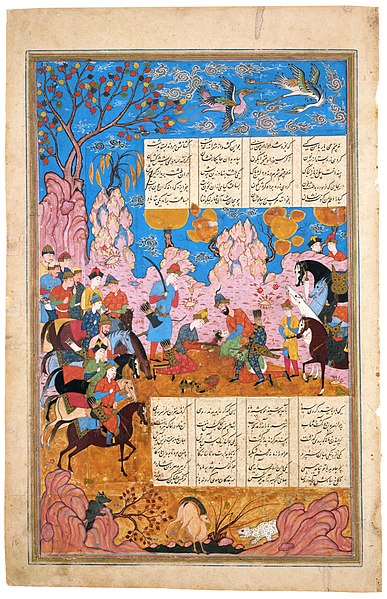Siyâvash or Siyâvoš or Siavash is a major figure in Ferdowsi's epic, the Shahnameh. He was a legendary Iranian prince from the earliest days of the Iranian Empire. A handsome and desirable young man, his name literally means "the one with black stallions". Ferdowsi, the author of the Book of Kings (Shahnameh), names his horse Shabrang Behzād.
The Slaying of Siyâvash
Siyavash is Pulled from His Bed and Killed
Siyavash faces Afrasiyab across the Jihun River, from Master of the Jainesque Shahnama, 15th century, Sultanate India.
The blood-red flowers of Fritillaria imperialis are said, in Iranian folklore, to bow their heads and weep for the blameless and martyred Siyâvash and this may be the identity of the plant Khune Asyavushan ('the blood of Siyâvash')
The Shahnameh, also transliterated Shahnama, is a long epic poem written by the Persian poet Ferdowsi between c. 977 and 1010 CE and is the national epic of Greater Iran. Consisting of some 50,000 distichs or couplets, the Shahnameh is one of the world's longest epic poems, and the longest epic poem created by a single author. It tells mainly the mythical and to some extent the historical past of the Persian Empire from the creation of the world until the Muslim conquest in the seventh century. Iran, Azerbaijan, Afghanistan, Tajikistan and the greater region influenced by Persian culture such as Armenia, Dagestan, Georgia, Turkey, Turkmenistan and Uzbekistan celebrate this national epic.

Plate with a hunting scene from the tale of Bahram Gur and Azadeh. The imagery on this plate represents the earliest known depiction of a well-known episode from the story of Bahram Gur, which seems to have been popular for centuries, but was only recorded in the Shahnameh, centuries after this plate was created. Iran, c. 5th century A.D. Metropolitan Museum of Art
'Rostam cycle', fragment of the Penjikent murals in the Hermitage Museum. 7-8th-century
Beaker (mina'i ware) illustrating the story of Bijan and Manijeh. Iran, late 12th century. Freer Gallery of Art
Page from the Florence Shahnameh, the oldest known Shahnameh manuscript. Anatolia, 1217. National Central Library of Florence








